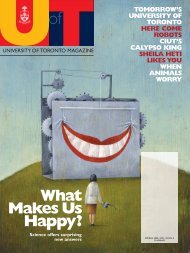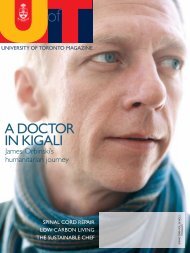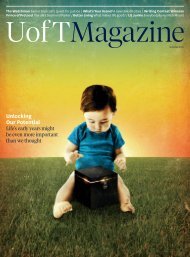The Next Big Idea 10 concepts that could - University of Toronto ...
The Next Big Idea 10 concepts that could - University of Toronto ...
The Next Big Idea 10 concepts that could - University of Toronto ...
Create successful ePaper yourself
Turn your PDF publications into a flip-book with our unique Google optimized e-Paper software.
photo: Sean Robertson<br />
his motor stopped 800 feet in the air, and wind capsized the<br />
plane, before he righted it and glided to a violent landing.<br />
McCurdy continued to believe the plane would play a role<br />
in future wars, and in exhibitions he would drop oranges,<br />
which he called bombs, on targets identified as battleships to<br />
prove his point. Some Japanese observers at a U.S. airshow<br />
took note, and wasted no time placing orders for planes on<br />
behalf <strong>of</strong> their military.<br />
Even the onset <strong>of</strong> the First World War didn’t change the mind<br />
<strong>of</strong> the Canadian government, though, with Sam Hughes, the<br />
minister <strong>of</strong> militia and defence, blustering at McCurdy: “<strong>The</strong><br />
aeroplane is an invention <strong>of</strong> the devil and will never play any<br />
part in such a serious business as the defence <strong>of</strong> the nation.”<br />
“I am sure,” the young man said quietly, “you will live to<br />
regret those words, General Hughes.”<br />
During the First World War, McCurdy and Curtiss helped<br />
supply aircraft to the British, and McCurdy ran a flight-training<br />
school in <strong>Toronto</strong>, sending trainees to join the newborn British<br />
air force. (It was only in the 1920s <strong>that</strong> Canada belatedly<br />
inaugurated its own flying force.) Soon after the war, McCurdy<br />
met and married a Woodstock, Ontario, beauty, Margaret Ball –<br />
with whom he’d have a boy and a girl.<br />
Throughout his life, McCurdy would continue to contribute<br />
to the growth <strong>of</strong> aeronautics in Canada – albeit in less dramatic<br />
ways than he did in his youth. In the 1920s and ’30s, he was<br />
president <strong>of</strong> the Curtiss-Reid aircraft company, which sold<br />
civilian aircraft around the world. In the Second World War,<br />
he oversaw Canadian aircraft production. From 1947 to 1952,<br />
McCurdy served as Nova Scotia’s lieutenant-governor and<br />
there are photos in his province’s archives <strong>of</strong> the still lean,<br />
distinguished-looking man squiring the impossibly younglooking<br />
Crown Princess Elizabeth about Halifax.<br />
McCurdy never retired from flying, becoming, before his<br />
death in 1961 at age 74, the oldest licensed pilot in the world.<br />
In his later years, he sometimes spoke about his early flights –<br />
“he wouldn’t talk much about them, unless you asked,” Haddon<br />
says. When people did press him, the Cuban flight generally<br />
took pride <strong>of</strong> place among his recollections. In speeches and<br />
radio broadcasts, he tended to spend the longest time describing<br />
it, lingering fondly over the enthusiasm and duplicity <strong>of</strong> his<br />
hosts, remembering <strong>that</strong> stunning mirage over the water.<br />
Among the many firsts, the inventions and innovations he<br />
helped in, the successful take<strong>of</strong>fs and flights, the crashes he’d<br />
somehow survived, there was this: McCurdy was the first man<br />
to have such confidence in himself and his plane to head so<br />
far out over the open sea <strong>that</strong> he lost sight <strong>of</strong> land.<br />
Alec Scott (LLB 1994) splits his time between <strong>Toronto</strong> and San<br />
Francisco. He writes frequently about arts, travel and the law.<br />
Like a Bird<br />
In August, a U <strong>of</strong> T engineering<br />
student became the first ever to fly<br />
a human-powered “ornithopter”<br />
<strong>The</strong>re may be no one who<br />
better understands how Douglas<br />
McCurdy felt during his first<br />
flight a century ago than Todd<br />
Reichert, who is an engineering<br />
PhD student at U <strong>of</strong> T.<br />
Last August, in Tottenham,<br />
Ontario, Reichert became the<br />
first person to fulfil the vision<br />
Leonardo DaVinci set down in his<br />
notebooks in 1485 – <strong>of</strong> flying a<br />
human-powered vehicle through<br />
the air like a bird. “This is the<br />
original aeronautical dream,”<br />
Reichert says. “Humans have<br />
always wanted to fly like birds.”<br />
On a quiet summer morning,<br />
Reichert pedalled hard to get his<br />
43-kilogram craft’s immense<br />
wings flapping; at 32 metres<br />
from tip to tip, the Snowbird’s<br />
wingspan equals <strong>that</strong> <strong>of</strong> a Boeing<br />
737. Al<strong>of</strong>t for 20 seconds, the<br />
“ornithopter” covered a distance<br />
<strong>of</strong> 145 metres at an average<br />
speed <strong>of</strong> 26 kilometres an hour.<br />
Like McCurdy before him,<br />
Reichert had a core group <strong>of</strong> four<br />
behind him: U <strong>of</strong> T pr<strong>of</strong>essor<br />
emeritus James DeLaurier,<br />
playing the role <strong>of</strong> Alexander<br />
Bell; Cameron Robertson<br />
(MASc 2009), the chief structural<br />
engineer; and two aviation<br />
enthusiasts from Vancouver, high<br />
school student Robert Dueck<br />
and his father, Carson. <strong>The</strong>y call<br />
themselves the “five amigos.”<br />
Another 30 U <strong>of</strong> T students<br />
helped during the four years <strong>of</strong><br />
designing and building the craft.<br />
<strong>The</strong> key engineering problem:<br />
the wings had to shift their angle<br />
<strong>of</strong> attack between the upstroke<br />
and downstroke, thereby providing<br />
sufficient lift and forward<br />
propulsion.<br />
Like his predecessor<br />
McCurdy, Reichert had his share<br />
<strong>of</strong> bad landings along the way:<br />
“I never flew higher than I was<br />
willing to fall. I did get a scratch<br />
once, but mainly when I was<br />
coming in for a crash, I was<br />
thinking, ‘Oh crap, we have to<br />
repair this thing.’” – Alec Scott<br />
Watch a video <strong>of</strong><br />
Reichert’s historic flight at<br />
www.magazine.utoronto.ca.<br />
Engineering PhD student Todd Reichert flew a flapping-wing airplane for<br />
20 seconds, covering a distance <strong>of</strong> 145 metres<br />
winter 2011 45
















